Budgeting for the Next Pandemic
The current crisis has already cost more than $5 trillion in direct spending; we must develop a better strategy for future pandemics.
COVID-19 is the most expensive pandemic and one of the costliest crises in modern world history. Even without assessing economic and health-related impacts, the pandemic has cost governments around the world trillions of dollars with the U.S. alone providing more than $5 trillion in direct fiscal response. As hopeful signs of recovery emerge, there is a compelling need here in the United States for a more capable, integrated and well-executed preparedness strategy—and accompanying budgetary approach—to mitigate the adverse consequences of pandemics and other biological threats and enhance our readiness to respond quickly and effectively when one occurs.
The need for such a strategy is driven not only by fiscal considerations but also vital national security and international competitiveness concerns. As a case in point, China was able to generate goodwill in much of the developing world by exporting its low-cost vaccine under a Health Silk Road moniker. Meanwhile, the Trump administration was pursuing a policy of making and stockpiling vaccines for domestic use while disengaging globally. While the Biden administration is reversing those policies (such as by funding COVAX, a multinational initiative to promote global access to vaccines), China’s efforts to be viewed as a protector of global public health has likely heightened its international standing.
Here in the United States, already in a trillion-dollar deficit pattern, fiscal conditions worsened from the additional borrowing required to fund COVID-19 response activities. That additional red ink amounts to about $40,000 on the national debt tab of each American household. What’s more, there’s no guarantee of avoiding a repeat expense in the future. If forced to borrow that much to pay for, say, a home repair, a rational household would take mitigating actions (e.g., buy insurance) to lessen the impact of future incidences. Extending that logic to the national level, the United States should take steps to ensure costs of this magnitude do not recur.
The American Rescue Plan Act provides tens of billions of dollars in new funding for activities involving vaccinations, public health and pandemic preparedness. But for past biological events, such as the 2009 H1N1 influenza pandemic and the 2014 Ebola epidemic, preparedness funding similarly ramped up but was not maintained. (Contrast that with post-9/11 funding for terrorism threats or longstanding national security priorities where funding has remained at heightened levels.) If past is prologue, we risk moving on after the pandemic has eased without addressing the continuing risk of pandemics. While the 100-year flood metaphor doesn’t even seem to apply to floods these days, it surely isn’t applicable to pandemics and other biological threats—the next one could occur at any time.
As we shift focus from immediate COVID-19 response to more general pandemic preparedness, the Biden administration should articulate a strategic budgetary plan, including the smart use of taxpayer dollars that emphasizes a comprehensive and durable approach. Key elements of such a strategy include:
Cross-agency priority goals. A severe pandemic mobilizes agencies well beyond the health agency alphabet soup of HHS, CDC, NIH and FDA. Departments as diverse as Treasury, Commerce, Agriculture, Housing and Urban Development and the Small Business Administration are all playing new or extended roles in providing COVID-19 relief. For the first time, FEMA is responding to a biological event as a major disaster. Accordingly, it is critically important for the government to shift focus away from disparate programs and towards a coherent and coordinated preparedness strategy that cuts across agency boundaries and Congressional committee jurisdictions.
There’s already a law on the books requiring the White House budget office to coordinate with agencies to establish a limited set of CAP goals to accelerate progress on the highest priority areas where collaboration across agencies is necessary to meet a critical national need. The designation of a CAP goal would improve accountability, transparency and governance not only by enhancing inter-agency coordination but also by naming accountable officials, conducting data-driven reviews of spending with clear performance targets, and reporting to the public on performance.gov. After our experience of the past year, it’s hard to imagine there are many higher priority areas right now than pandemic preparedness.
Industrial engagement. Federal agencies must find ways to engage with non-governmental and state and local partners to ensure coordination of effort and funding. One of the many unfulfilled recommendations from a 2010 post-pandemic report suggested an advisory committee, comprising representatives from the biotechnology, pharmaceutical and investment communities, to guide engagement with industry. That suggestion remains highly relevant today given the importance of the relationship between government and industry partners. Policymakers need to understand that vital capabilities related to biopharma and healthcare largely reside in the private sectors. While federal investments are necessary to build a strong national pandemic defense, so are substantial contributions from private industry, non-federal governmental organizations and others. Strategic budgeting must recognize, plan for and incorporate this mixed investment model.
Financial innovation. The United States should explore a broader portfolio of funding mechanisms to include direct contributions (i.e., grants, tax incentives, loans), innovative finance mechanisms (e.g., vaccine bonds or megafunds to ensure more shots on goal in vaccine research) and public-private partnerships that drive investments in modern vaccine production. Such innovations should be considered not in isolation but as part of a diversified portfolio of preparedness projects.
International engagement. Organizations such as the Gavi Vaccine Alliance and the Coalition for Epidemic Preparedness Innovations formed this century to fund and develop vaccines. Unfortunately, the United States has not been an active participant in recent years but actions by the Biden administration indicate that stance is changing. With all people affected by a pandemic, the United States must not only re-engage but provide flexible funding to enable more worthwhile participation.
Some have described the need to invest in new platforms and technologies to prepare for future pandemics as a moonshot-type undertaking. Perhaps a more apt metaphor is a Star Wars-like missile defense system that obliterates microbes instead of ICBMs. Unlike missile defense systems, though, no matter how advanced the technologies become for vaccines and pandemic preparedness, effective response will largely depend on the behaviors of individuals (social distance, wear a mask, get a test/vaccinate). There’s plenty of room under a fortified pandemic preparedness shield but it only protects if we all take hold.
Doug Criscitello, a former official with the Congressional Budget Office and the Office of Management and Budget, is a Managing Director with Grant Thornton Public Sector LLC. He is a Fellow of the National Academy of Public Administration.








